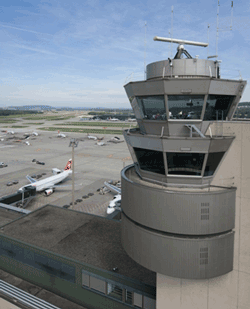25th anniversary of the control tower in Zurich
- Like
- Digg
- Del
- Tumblr
- VKontakte
- Buffer
- Love This
- Odnoklassniki
- Meneame
- Blogger
- Amazon
- Yahoo Mail
- Gmail
- AOL
- Newsvine
- HackerNews
- Evernote
- MySpace
- Mail.ru
- Viadeo
- Line
- Comments
- Yummly
- SMS
- Viber
- Telegram
- Subscribe
- Skype
- Facebook Messenger
- Kakao
- LiveJournal
- Yammer
- Edgar
- Fintel
- Mix
- Instapaper
- Copy Link
Posted: 28 April 2011 | Skyguide | No comments yet
Exactly 25 years ago, during the night of 28 to 29 April 1986, the current control tower at Zurich airport came into operation for the first time…
Exactly 25 years ago, during the night of 28 to 29 April 1986, the current control tower at Zurich airport came into operation for the first time. It is the third building of its kind on the site since air traffic was moved from Dübendorf to Zurich Kloten in the 1940s. Nowadays, the air traffic controllers in the tower monitor an average of 700 arrivals and departures every day, which is almost 50 percent more than 25 years ago.


Second control tower 1986 to today
In the control tower, around 70 air traffic controllers man the three work positions in shifts. Sitting at a height of more than 40 metres, they monitor take-offs and landings and the movement of aircraft and vehicles on the runways. The tower is manned 24 hours a day and 365 days a year, including at night when the airport is closed. This allows a service to be provided immediately if required, for example in the case of a medical emergency. The volume of air traffic has increased significantly over the last 25 years. In 1986, skyguide was responsible for monitoring around 440 arrivals and departures every day. Now the figure is more than 700 per day or almost 260,000 per year. With the growing numbers of aircraft movements, coordinating and monitoring traffic in the airways and on the runways has become an increasingly complex task.
From Dübendorf to Zurich Kloten
Zurich has a long history of providing air navigation services. The first temporary “tower” in a wooden hut came into operation in 1948 when air traffic was moved from Dübendorf to Zurich Kloten. Within a year, other air traffic management services, including the meteorological and the technical service, transferred from the airfield in Dübendorf to Zurich. After the completion of the terminal building, also referred to as the “Flughof”, and the official opening of Zurich airport, in 1953 the air traffic controllers were able to leave their temporary tower and move into a new and more spacious control tower. This remained in operation for 33 years, until the current tower was built. When the new skyguide building at Dübendorf airfield was completed in 2005, the air traffic management services gradually moved back to the place where everything had started. Only the control tower stayed in its existing location at Zurich airport.
Unstoppable technical development
After the Second World War, the aviation industry saw rapid technical development. At the end of the 1940s, Morse telegraphy, which involved transmitting text in code form over long distances, was replaced by radio systems. This made communication between aircraft and the ground much easier. The direct finding system which allowed ground stations to locate aircraft in their airspace was developed further in the 1950s with the establishment of the first radar stations. In Zurich the first radar station was built in 1954 on the Holberg. The possibility of displaying on a screen the aircraft in a large area of airspace radically changed the work of air traffic controllers. Originally, they were only responsible for transmitting information, but over time they gradually began to take on a control function. During the post-war period, there was also a move from visual to instrument navigation, which resulted from pilots’ need to navigate independently of the ground. At the end of the 1940s, the first omni-directional radio beacon came into operation. This ground station acted as a navigation aid for pilots. As the amount of air traffic increased, airways slowly became established. These made the job of the air traffic controllers much easier, because the routes taken by aircraft were more predictable. Another major achievement was the introduction of an instrument landing system (ILS) which allowed pilots to land planes safely even in poor visibility.
IT systems offer new opportunities
IT systems opened up new possibilities for air navigation services during the 1980s. Work processes have become more efficient, in particular with regard to processing the flight plans submitted by pilots before every flight. Aircraft can be displayed on radar screens together with their flight number and other important information, such as their course and height. Data is transmitted electronically rather than manually, which eliminates one potential source of errors. Valuable safety nets have also been introduced to provide support for air traffic controllers. These include collision warning systems, which identify possible conflicts on the basis of the flight plan data and alert the air traffic controllers responsible in good time. Skyguide is constantly improving its systems and will continue the process of introducing more IT support into the air traffic controllers’ workplaces over the next few years.













